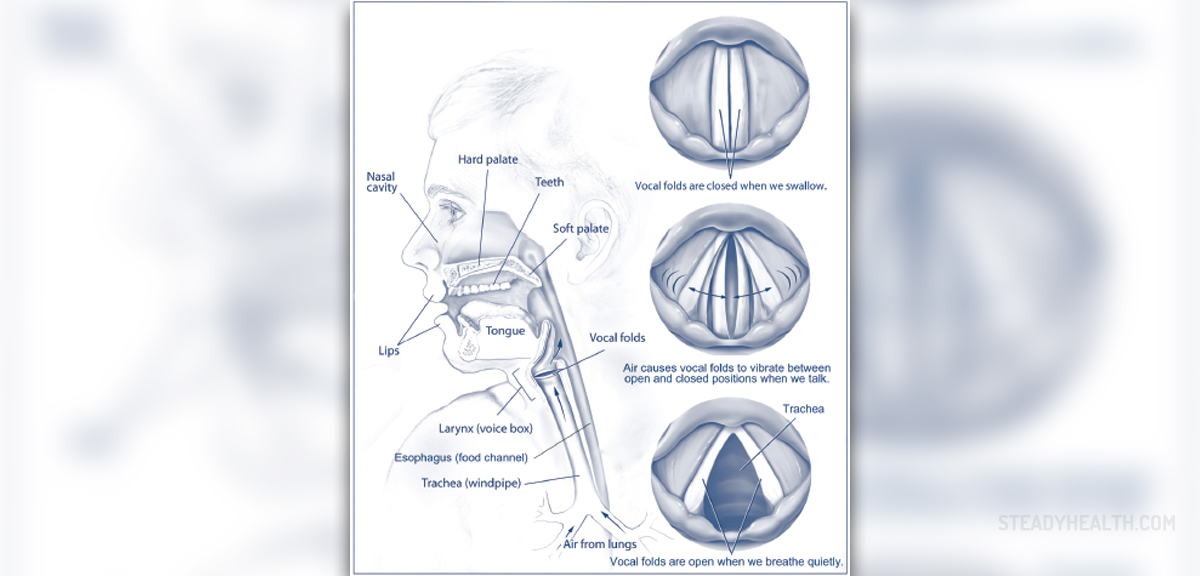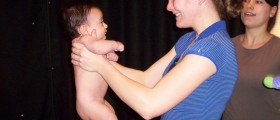Vocal cords consist of two elastic muscles by the side of larynx and like any other muscle or tissue in our body could suffer from strain or damage.
Singers, teachers, lawyers and actors have increased risk of strained vocal cords, as well as the people who work at airports or racing tracks.
The most common vocal cords illnesses are vocal cords nodules sometimes called teachers’ or singers’ nodules. Exposure to cigarette smoke or chemicals might induce vocal cord polyps. In these conditions the voice changes becomes rough and breathy, and some singers lose their vocal range. The nodules usually last 6 to 12 weeks with the proper voice training with the specialist, but most of the polyps should be surgically removed.

Swelling of the Vocal Cords
Laryngitis is the swelling of the cords, usually because of the infection or inflammation. Suffering from laryngitis, your voice might be changed or in serious cases you could totally lose the possibility to speak (just temporarily, while the infection lasts). It may last for a couple days, or in viral infection, it last up to three weeks.
- The most common cause of acute laryngitis is viral upper respiratory infection (URI), and this diagnosis can often be obtained from taking a thorough history of present illness from the patient. In the absence of infectious history or sick contacts, additional causes of non-infectious laryngitis must be explored.
- Presenting symptoms often include voice changes (patients may report hoarseness or a "raspy" voice), early vocal fatigue (particularly in singers or professional voice users), or a dry cough. Breathing difficulties are rare (though possible) in acute laryngitis, but the presence of significant dyspnea, shortness of breath (SOB), or audible stridor should alert the clinician that a more dangerous disease process may be present.
- Viral agents such as rhinovirus, parainfluenza virus, respiratory syncytial virus, coronavirus, adenovirus, and influenza are all potential etiologic agents (listed in roughly descending order of frequency). It is possible for bacterial superinfection to occur in the setting of viral laryngitis, this classically occurs approximately seven days after symptoms begin.
- Acute infectious laryngitis in adults is most commonly caused by the viral organisms listed above. These same agents are common in pediatric acute laryngitis, though it is important to remember croup (laryngotracheobronchitis) in children, which is due to parainfluenza virus (most commonly parainfluenza-1). This may present with isolated vocal symptoms, but classically includes a characteristic "barking" cough and may progress to inspiratory or biphasic stridor.
- Acute non-infectious laryngitis can be due to vocal trauma/abuse/misuse, allergy, gastroesophageal reflux disease, asthma, environmental pollution, smoking, inhalational injuries, or functional/conversion disorders.
- Gastroesophageal reflux (GERD), more specifically extra-esophageal GERD, termed laryngopharyngeal reflux (LPR), is an exceptionally common cause of voice symptoms and laryngitis. These symptoms can be acute or chronic and may be episodic. They may not follow or accompany the classic GERD symptoms, and 1/3 of patients with GERD will experience only laryngeal/voice symptoms. Hallmarks include a history of GERD, frequent throat-clearing or coughing, globus pharyngeus sensation, or coarseness to the voice. Singers may note a loss of their higher range.
Contact ulcers are rare, common for people who work in noisy surrounding or GERD (gastroesophageal reflux) and heartburn patients. Their voice is rough, tires often and the throat is painful. The recovery is slow – 6 weeks of rest are necessary for ulcers to heal.
Vocal cord paresis appears when there’s a problem with the opening and closing of one of the cords, and it usually results in changed voice. When one or both of the cords do not move the condition is called vocal cord paralysis. Causes of vocal cord paresis and paralysis include viral infections, weak vocal cord muscles, neck or chest surgery or injury, trauma during birth, stroke or tumor. Sometimes, patients suffering from Parkinson’s, myasthenia gravis or MS (multiple sclerosis) are also susceptive to these vocal cord conditions. Changes in your voice are present with this condition and paralyzed cords may bring discomfort and some breathing problems. The voice could come back in a year, but sometimes the voice loss is permanent.
Vocal Cord Pain Diagnosis and Prognosis
Men after 60 have increased risk of vocal cord tumors. Malignant (cancerous) tumors appear more in smokers and alcoholics and if they’re caught in early stages, the prognosis is usually good. Tumors usually roughen your voice and sometime they might affect the breathing and swallowing. Benign tumors must be surgically removed and cancerous tumors should be treated instantly, because of the possible fatal consequences.
To get the proper diagnosis, doctor will ask about your medical history, listen to your voice and examine your vocal cords with a small mirror or laryngoscope. You’d be asked to speak while the procedure is ongoing, enabling the doctor to see your vocal cords active. In some cases, acoustic analysis is required. If suspected to have cancerous growth, the doctor will recommend a biopsy and sometimes additional tests to diagnose the proper cause of the vocal cords condition.

















Your thoughts on this
Loading...